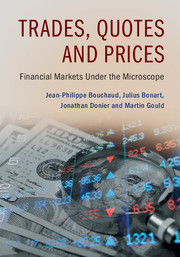Book contents
- Frontmatter
- Dedication
- Contents
- Preface
- Acknowledgements
- PART I HOW AND WHY DO PRICES MOVE?
- PART II LIMIT ORDER BOOKS: INTRODUCTION
- PART III LIMIT ORDER BOOKS: MODELS
- PART IV CLUSTERING AND CORRELATIONS
- PART V PRICE IMPACT
- PART VI MARKET DYNAMICS AT THE MICRO-SCALE
- PART VII ADVERSE SELECTION AND LIQUIDITY PROVISION
- PART VIII MARKET DYNAMICS AT THE MESO-SCALE
- PART IX PRACTICAL CONSEQUENCES
- Appendix
- Index
Appendix
Published online by Cambridge University Press: 26 February 2018
- Frontmatter
- Dedication
- Contents
- Preface
- Acknowledgements
- PART I HOW AND WHY DO PRICES MOVE?
- PART II LIMIT ORDER BOOKS: INTRODUCTION
- PART III LIMIT ORDER BOOKS: MODELS
- PART IV CLUSTERING AND CORRELATIONS
- PART V PRICE IMPACT
- PART VI MARKET DYNAMICS AT THE MICRO-SCALE
- PART VII ADVERSE SELECTION AND LIQUIDITY PROVISION
- PART VIII MARKET DYNAMICS AT THE MESO-SCALE
- PART IX PRACTICAL CONSEQUENCES
- Appendix
- Index
Summary
Description of the NASDAQ Data
Throughout the book, our empirical calculations are based on historical data that describes the LOB dynamics during the whole year 2015 for 120 liquid stocks traded on NASDAQ. On the NASDAQ platform, each stock is traded in a separate LOB with a tick size of ϑ = $0.01. The platform enables traders to submit both visible and hidden limit orders. Visible limit orders obey standard price–time priority, while hidden limit orders have lower priority than all visible limit orders at the same price. The platform also allows traders to submit mid-price-pegged limit orders. These orders are hidden, but when executed, they appear with a price equal to the national mid-price (i.e. the mid-price calculated from the national best bid and offer) at their time of execution. Therefore, although the tick size is $0.01, some orders are executed at a price ending with $0.005.
The data that we study originates from the LOBSTER database (see below), which lists every market order arrival, limit order arrival, and cancellation that occurs on the NASDAQ platform during 09:30–16:00 each trading day. Trading does not occur on weekends or public holidays, so we exclude these days from our analysis.When we calculate daily traded volumes or intra-day patterns, we include all activity during the full trading day. In all other cases, we exclude market activity during the first and last hour of each trading day, to remove any abnormal trading behaviour that can occur shortly after the opening auction or shortly before the closing auction.
For each stock and each trading day, the LOBSTER data consists of two different files:
• The message file lists every market order arrival, limit order arrival and cancellation that occurs. The LOBSTER data does not describe hidden limit order arrivals, but it does provide some details whenever a market order matches to a hidden limit order (see discussion below).
• The orderbook file lists the state of the LOB (i.e. the total volume of buy or sell orders at each price). The file contains a new entry for each line in the message file, to describe the market state immediately after the corresponding event occurs.
- Type
- Chapter
- Information
- Trades, Quotes and PricesFinancial Markets Under the Microscope, pp. 422 - 440Publisher: Cambridge University PressPrint publication year: 2018

